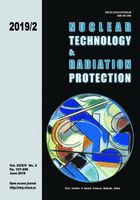
RADIOLOGICAL SAFETY ASSESSMENT FOR INCIDENT-FREE TRANSPORTATION OF RADIOACTIVE DECONTAMINATION WASTE AFTER THE FUKUSHIMA NUCLEAR POWER PLANT ACCIDENT
Pages: 201-208
Authors: Min Jun KIM, Ji Young Song, Jin Ho Park, Tae Gwan Do, Jin O Lee,
and Kwang Pyo KimAbstract
Radioactive decontamination waste generated by remediation following the Fukushima nuclear power plant accident was recently transported from its temporary storage sites to interim storage facilities as a pilot test. A transportation plan for the radioactive decontamination waste will be developed based on this pilot transportation experience and radiological safety assessment of pilot transportation. The objective of this study was to assess radiation doses to the public and crew workers released during incident-free pilot transportation. External dose rates around a transportation vehicle were calculated by using the Monte Carlo N-Particle code. Collective doses and maximally exposed individual doses to the public and effective doses to crew workers were calculated by using INTERTRAN. Two transportation routes, Asakawa-machi to Okuma-machi and Iwaki-shi to Okuma-machi, were considered. The maximum radioactivity concentration in the decontamination waste was calculated to be 660 kBqkg-1 which meets the value laid down by the guidelines of Japan's Ministry of the Environment. The collective doses to the public per shipment were 1.9·10-3 person-mSv for the Asakawa route and 2.2·10-4 person-mSv for the Iwaki route. Maximally exposed individual doses to the public were 9.6·10-7 mSv for the Asakawa route and 2.7·10-5 mSv for the Iwaki route. The total effective doses to crew workers were 0.27 mSv for the Asakawa route assuming five shipments per worker and 1.07 mSv for the Iwaki route assuming 45 shipments per worker. The radiation dose levels to the public and workers evaluated in this study were much lower than the annual dose limits for the general public and radiation workers. These study results can be used to develop transportation plans and guidelines for decontamination waste transportation.
Key words: Fukushima nuclear power plant accident, decontamination waste, interim storage facility, transportation, safety assessment
FULL PAPER IN PDF FORMAT (983 KB)
